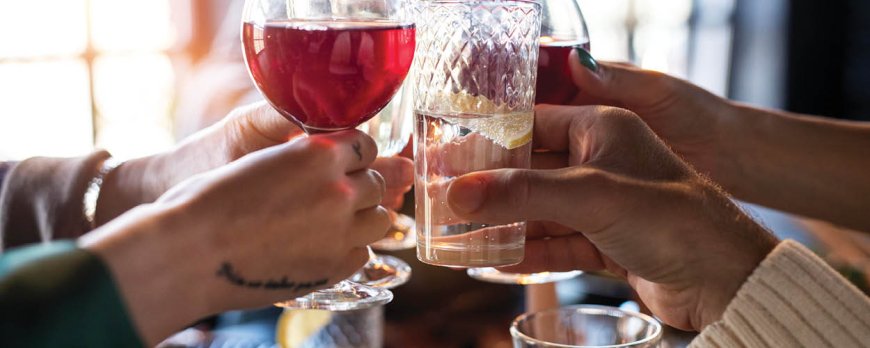What is GREY area drinking?
Explore "What is GREY area drinking?" Uncover insights into this ambiguous alcohol consumption pattern and its potential impacts on health and lifestyle.

What is GREY area drinking?
Grey area drinking refers to a zone between moderate drinking and rock bottom, where individuals don't have a physical dependency on alcohol but still engage in problematic drinking patterns. It is estimated to affect over 75 million Americans and has seen a significant increase during the pandemic.
Key Takeaways:
- Grey area drinking is a term used to describe problematic drinking patterns that fall between moderate drinking and alcohol dependency.
- It does not involve physical addiction, but individuals still engage in behaviors that can have negative impacts on their health and lifestyle.
- Anxiety, preoccupation with drinking, and experiencing hangxiety after heavy alcohol use are common signs of grey area drinking.
- Building tolerance, blacking out from drinking, and experiencing strain in relationships are also indicators of problematic drinking patterns.
- To address grey area drinking, individuals can assess their drinking habits, practice mindful drinking, take breaks from alcohol, and seek support from available resources.
- It is important to address grey area drinking before it escalates and leads to severe consequences.
Understanding the Impact of Grey Area Drinking
Grey area drinking can have significant impacts on both physical and mental health, as well as on various aspects of one's lifestyle. It refers to a zone between moderate drinking and rock bottom, where individuals don't have a physical dependency on alcohol but still engage in problematic drinking patterns. It is estimated to affect over 75 million Americans and has seen a significant increase during the pandemic.
Signs of grey area drinking include anxiety and preoccupation with drinking, experiencing hangxiety after heavy alcohol use, building tolerance or blacking out from drinking, relationship issues, and restlessness about drinking. These behaviors and symptoms can have a profound impact on one's overall well-being and quality of life.
To address the impact of grey area drinking, it is crucial to assess the circumstances and changes in drinking habits. Making drinking a mindful practice can help individuals set limits and practice moderation in alcohol consumption. Additionally, taking a break from drinking and paying attention to the positive changes that come with sobriety can be beneficial. Seeking support from available resources, such as hotlines, online communities, or professional help, is also essential for individuals dealing with grey area drinking.
It is important to address grey area drinking before severe consequences arise. By understanding the potential impacts on health and lifestyle, individuals can take proactive steps towards healthier choices and seek the help they need to overcome problematic drinking patterns.

Signs and Symptoms of Grey Area Drinking
There are several telltale signs that may indicate an individual is engaged in grey area drinking. These signs often include feelings of anxiety and preoccupation with drinking, leading to an increased desire to consume alcohol. It is not uncommon for individuals experiencing grey area drinking to engage in heavy alcohol use and then experience hangxiety, a combination of hangover symptoms and anxiety.
One significant characteristic of grey area drinking is the development of tolerance. As individuals continue to consume alcohol, their bodies adapt, requiring larger quantities to achieve the desired effects. This can lead to frequent blackouts and memory lapses, indicating a problematic pattern of drinking. Furthermore, grey area drinking can strain relationships, as excessive alcohol consumption often results in conflicts, communication breakdowns, and a lack of trust.
Restlessness about drinking is another symptom commonly associated with grey area drinking. An individual may find themselves constantly thinking about their next drink, planning their activities around alcohol consumption, or feeling restless when not drinking. These behaviors can indicate a problematic relationship with alcohol and may warrant further attention and evaluation.
Recognizing the Signs:
- Anxiety and preoccupation with drinking
- Hangxiety after heavy alcohol use
- Building tolerance or experiencing blackouts
- Relationship issues due to excessive drinking
- Restlessness and constant thoughts about drinking
Recognizing these signs and symptoms is crucial in identifying grey area drinking and addressing it before it escalates. By becoming aware of these behaviors, individuals can seek appropriate support and make positive changes towards healthier choices and responsible alcohol consumption.
The Rise of Grey Area Drinking during the Pandemic
The COVID-19 pandemic has led to a significant increase in grey area drinking, affecting millions of Americans. As people grappled with the uncertainties and stressors brought about by the global health crisis, many turned to alcohol as a coping mechanism. The isolation, financial hardship, and disrupted routines created an environment ripe for excessive alcohol consumption and the emergence of grey area drinking patterns.
During the pandemic, alcohol consumption patterns shifted dramatically. With bars and restaurants closed or operating at limited capacity, individuals began drinking more frequently at home. This change in the social landscape, coupled with increased stress and anxiety, contributed to a rise in problematic drinking behaviors that fall within the grey area.
Grey area drinking during the pandemic encompasses a spectrum of behaviors, from occasional binge drinking to habitual excessive drinking without physical dependence. It is crucial to recognize and address these patterns, as they can have long-lasting impacts on individuals' mental and physical health, as well as their relationships.
As we navigate the ongoing challenges of the pandemic, it is vital to prioritize the well-being of ourselves and our communities. By understanding the factors that contribute to grey area drinking in this unique context, we can take proactive steps to promote responsible alcohol consumption, seek support when needed, and ultimately foster healthier habits amidst these uncertain times.

Addressing Grey Area Drinking: Strategies and Solutions
Recognizing the issue and taking steps to address grey area drinking is crucial for individuals' well-being. With over 75 million Americans estimated to be affected by grey area drinking, it is important to understand the strategies and solutions available to promote responsible drinking habits and make positive changes.
Assessing Drinking Habits and Making Changes
The first step in addressing grey area drinking is to assess one's drinking habits and identify areas that may need improvement. This can involve keeping track of alcohol consumption, setting limits on the amount and frequency of drinking, and monitoring the effects it has on physical and mental well-being. By analyzing patterns and behaviors associated with grey area drinking, individuals can make informed decisions about how to modify their habits and reduce the risks.
Key strategies:
- Keep a journal or use mobile apps to track alcohol consumption.
- Set realistic limits on the amount and frequency of drinking.
- Identify triggers and situations that lead to excessive drinking and develop coping mechanisms.
Embracing Mindful Drinking Practices
Mindful drinking is an approach that involves being present and conscious of one's alcohol consumption. This entails savoring each sip, paying attention to the taste and effects of alcohol, and understanding one's personal limits. By practicing mindful drinking, individuals can foster a healthier relationship with alcohol, make more conscious choices, and reduce the chances of falling into the grey area drinking zone.
Key strategies:
- Take time to fully experience the taste and effects of each drink.
- Engage in alternate activities or hobbies that don't involve alcohol.
- Participate in alcohol-free social events or gatherings.
Taking a Break and Embracing Sobriety
For individuals looking to make significant changes and break free from grey area drinking, taking a break from alcohol or embracing sobriety can be transformative. This can involve a temporary period of abstinence or a long-term commitment to living an alcohol-free lifestyle. By experiencing the benefits of sobriety, individuals can recalibrate their relationship with alcohol, improve physical and mental health, and gain a new perspective on life.
Key strategies:
- Set a specific time frame for sobriety or take it one day at a time.
- Seek support from friends, family, or support groups during the sobriety journey.
- Focus on the positive changes and improvements that come with giving up alcohol.
Addressing grey area drinking is a personal and ongoing process that requires self-reflection, commitment, and support. By implementing these strategies and solutions, individuals can make positive changes in their drinking habits, promote responsible alcohol consumption, and prioritize their overall well-being.

Mindful Drinking: A Key Approach for Grey Area Drinkers
Mindful drinking serves as an effective approach for individuals in the grey area of alcohol consumption, providing guidance and structure. It involves being present and intentional with one's drinking habits, paying attention to the why, when, and how much of alcohol consumption. By practicing mindfulness, individuals can gain a deeper understanding of their relationship with alcohol and make conscious choices to promote healthier habits.
One key aspect of mindful drinking is assessing the circumstances and triggers that lead to grey area drinking. This involves identifying situations, emotions, or social pressures that may influence excessive alcohol consumption. By recognizing these factors, individuals can develop strategies to navigate these challenges and make informed decisions about their drinking habits.
Mindful Drinking Strategies:
- Setting limits: Establishing clear boundaries and guidelines for alcohol consumption can help individuals stay within the realm of moderate drinking.
- Practicing moderation: Being mindful of alcohol intake and pacing oneself can prevent excessive drinking and its associated negative effects.
- Choosing quality over quantity: Opting for higher-quality alcoholic beverages and savoring the taste can promote a more mindful and enjoyable drinking experience.
- Exploring non-alcoholic alternatives: Incorporating alcohol-free options into social gatherings and events can reduce reliance on alcohol and provide healthier alternatives.
By adopting these mindful drinking strategies, individuals can regain control over their alcohol consumption and reduce the risk of slipping into problematic drinking patterns. It's important to remember that there is no one-size-fits-all approach, and what works for one person may not work for another. Seeking professional guidance and support can provide additional resources and personalized strategies to address grey area drinking effectively.
Addressing grey area drinking is crucial for individuals' overall well-being and quality of life. By recognizing the signs, practicing mindful drinking, and seeking support when needed, individuals can make positive changes and prevent the potential negative impact of excessive alcohol consumption in their lives.
Taking a Break: Benefits of Sobriety
Temporarily abstaining from alcohol can lead to significant positive changes for individuals in the grey area of drinking. Taking a break from drinking allows individuals to gain a fresh perspective on their alcohol consumption patterns and evaluate the impact it has on their health and overall well-being. It provides an opportunity to break free from the cycle of problematic drinking and make positive changes towards a healthier lifestyle.
During a period of sobriety, individuals often experience improved physical and mental health. They may notice increased energy levels, better quality of sleep, and improved cognitive function. By eliminating alcohol from their lives, individuals give their bodies a chance to heal and recover from the negative effects of excessive drinking.
Moreover, taking a break from drinking can have positive effects on relationships and personal growth. It allows individuals to focus on personal development, explore new hobbies and interests, and strengthen their connections with loved ones. Without the distractions of alcohol, individuals can engage in meaningful activities and build healthier, more fulfilling relationships.
Ultimately, choosing sobriety in the grey area of drinking can bring about a sense of empowerment and control over one's life. It opens up possibilities for personal growth, self-discovery, and long-term positive change. By taking a break from drinking, individuals can gain clarity, develop healthier coping mechanisms, and pave the way for a happier, more fulfilling future.
Seeking Support: Resources for Grey Area Drinkers
There are numerous resources available for individuals seeking support and guidance when facing grey area drinking. Whether you are looking for information, professional help, or a community of like-minded individuals, these resources can provide the necessary support to help you navigate this challenging situation.
1. Hotlines and Helplines:
If you need immediate assistance or someone to talk to, helplines and hotlines offer confidential and non-judgmental support. These services are staffed by trained professionals who can provide guidance and resources for managing grey area drinking. National helplines such as the Substance Abuse and Mental Health Services Administration (SAMHSA) helpline (1-800-662-HELP) or the National Drug Helpline (1-844-289-0879) can offer assistance.
2. Online Communities:
Connecting with others who have similar experiences can provide valuable support and encouragement. Online communities and forums dedicated to grey area drinking offer a safe space to share stories, seek advice, and find comfort in knowing that you are not alone. Websites like Soberistas and Grey Area Drinkers Anonymous provide platforms for individuals to connect and discuss their journeys.
3. Professional Help:
Seeking professional help from therapists or addiction specialists can be instrumental in addressing grey area drinking. They can provide personalized guidance, therapy, and treatment options tailored to your specific needs. Additionally, support groups such as Alcoholics Anonymous (AA) or Smart Recovery meetings can offer a structured environment for recovery.
Remember, reaching out for support is not a sign of weakness but a courageous step towards taking control of your drinking habits. These resources are here to help you through your journey and provide the necessary support and tools to overcome grey area drinking.
The Importance of Addressing Grey Area Drinking
Ignoring grey area drinking can lead to significant negative consequences in various areas of an individual's life. It is crucial to recognize and address this pattern of alcohol consumption to prevent further harm.
Consequences of grey area drinking can manifest physically, mentally, and within relationships. Prolonged engagement in problematic drinking patterns can result in damage to vital organs, increased risk of developing chronic health conditions, and impaired cognitive functions.
Furthermore, grey area drinking often goes hand in hand with emotional and psychological challenges. Individuals may experience heightened anxiety, mood swings, and a decreased ability to cope with stress. This can impact their overall well-being and quality of life.
Addressing grey area drinking is essential to mitigating negative impacts:
- Assessing circumstances and making changes in drinking habits is a vital step towards healthier choices.
- Mindful drinking practices, such as setting limits and practicing moderation, can help individuals regain control over their alcohol consumption.
- Taking a break from drinking can bring about positive changes, both physically and mentally, allowing individuals to reassess their relationship with alcohol.
- Seeking support through available resources, such as helplines, online communities, and professional help, can provide guidance and encouragement on the path towards recovery.
By addressing grey area drinking proactively, individuals can alleviate the potential negative consequences and improve their overall well-being. It is never too late to seek help and make positive changes towards a healthier and more fulfilling life.

Personal Stories: Overcoming Grey Area Drinking
Hearing personal stories of individuals who have confronted and overcome grey area drinking can be both inspiring and informative. These stories highlight the resilience and determination of those who have faced the challenges associated with problematic drinking patterns and have successfully made positive changes in their lives.
One such individual is Sarah, who found herself caught in the grey area of drinking after experiencing relationship issues and increased stress at work. Recognizing the negative impact alcohol was having on her mental health and overall well-being, she made the decision to seek help and make a change. Through therapy, support groups, and the implementation of mindfulness techniques, Sarah was able to regain control over her drinking habits and rebuild her life.
Another inspiring story is that of Mark, who realized he was using alcohol as a means to cope with anxiety and loneliness. Tired of the constant hangxiety and the toll it was taking on his relationships, Mark took a break from drinking and sought the support of a counselor. With their guidance, he learned healthier ways to manage stress and prioritize self-care, ultimately leading to a more fulfilling and balanced life.
Benefits of Sharing Personal Stories
Sharing personal stories of overcoming grey area drinking not only provides hope and inspiration to others facing similar challenges but also helps to reduce the stigma associated with seeking help and making positive changes. These stories serve as a reminder that anyone can find themselves in the grey area of drinking and that recovery is possible.
- They offer insights into the various strategies and approaches that can be effective in addressing grey area drinking.
- They highlight the importance of seeking professional help and utilizing available resources for support.
- They emphasize the positive changes that can occur when individuals choose sobriety or make mindful choices regarding their alcohol consumption.
By sharing these personal stories, we can foster understanding, empathy, and support for individuals struggling with grey area drinking, creating a community that encourages and celebrates their journeys towards a healthier and happier life.
Conclusion
Grey area drinking is a complex issue that affects a significant number of individuals, highlighting the need for awareness, support, and responsible choices. It refers to a zone between moderate drinking and rock bottom, where individuals don't have a physical dependency on alcohol but still engage in problematic drinking patterns. It is estimated that over 75 million Americans are impacted by grey area drinking, and unfortunately, this number has seen a significant increase during the pandemic.
Recognizing the signs and symptoms of grey area drinking is crucial for early intervention and prevention. These signs may include experiencing anxiety and preoccupation with drinking, feeling hangxiety after heavy alcohol use, building tolerance or experiencing blackouts, and experiencing strain on relationships due to drinking habits. Understanding these indicators can help individuals take proactive steps towards addressing their problematic drinking patterns.
There are strategies and solutions available for those seeking to address grey area drinking. It begins with assessing the circumstances and making changes in drinking habits. Practicing mindful drinking, setting limits, and practicing moderation can also help individuals regain control over their alcohol consumption. Taking a break from drinking and embracing sobriety can lead to positive changes in physical and mental health, relationships, and overall well-being.
It is important to address grey area drinking before severe consequences arise. By seeking help and utilizing available resources, individuals can find the support they need to navigate through this challenging issue. Hotlines, online communities, and professional assistance can provide guidance and encouragement on the journey towards healthier choices and responsible alcohol consumption.
FAQ
What is grey area drinking?
Grey area drinking refers to a zone between moderate drinking and rock bottom, where individuals don't have a physical dependency on alcohol but still engage in problematic drinking patterns.
What are the signs of grey area drinking?
Signs of grey area drinking include anxiety and preoccupation with drinking, experiencing hangxiety after heavy alcohol use, building tolerance or blacking out from drinking, relationship issues, and restlessness about drinking.
How has grey area drinking been impacted during the pandemic?
Grey area drinking has seen a significant increase during the pandemic, with factors such as stress, isolation, and changes in daily routines contributing to its rise.
How can grey area drinking be addressed?
Strategies for addressing grey area drinking include assessing the circumstances and changes in drinking habits, making drinking a mindful practice, taking a break from drinking, and seeking support from available resources.
What is mindful drinking and how does it help with grey area drinking?
Mindful drinking involves setting limits and practicing moderation in alcohol consumption. It can help individuals in the grey area drinking zone by promoting responsible drinking practices.
What are the benefits of sobriety for grey area drinkers?
Taking a break from drinking can lead to positive changes for individuals engaged in grey area drinking, such as improved physical and mental health, better relationships, and overall well-being.
Are there resources available for individuals dealing with grey area drinking?
Yes, there are resources and support available for individuals dealing with grey area drinking, including hotlines, online communities, and professional help options.
Why is it important to address grey area drinking?
It is important to address grey area drinking before severe consequences arise, as it can have negative impacts on physical and mental health, relationships, and overall well-being.
Are there personal stories of individuals overcoming grey area drinking?
Yes, there are personal stories and testimonials of individuals who have overcome or are actively addressing grey area drinking. These stories provide inspiration and insights into their journeys towards positive change.


































































































































